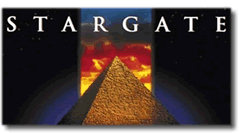Wooly Mammoth Stampedes, Grateful Sabretooth Cats,
Pyramid Building, and Slave Revolts:
Now that's Entertainment! Or, Perhaps Not.
10,000 B.C.
And they said, Go to,
let us build us a city and a tower,
whose top may reach unto heaven . . . .
— Genesis 11:4
Very deep is the well of the past. Should we not call it bottomless?
— Thomas Mann, Joseph and His Brothers
(New York: Alfred A. Knopf, 1966:3)
By Ron Fritze
March 12, 2008
I went to see 10,000 B.C. If you watch even a little TV, you've almost certainly seen the trailers promoting the movie. They are heady commercials, revealing in a flash all of the elements I mention in the title: fantastic creatures, amazing pyramids rising above the sand, and slaves in violent revolt. I was pretty interested and intrigued by it, but then, my wife tells me I am weird — and she may be on to something.
This movie is set in 10,000 B.C., but shows the building of pyramids. What's up with that? The great age of Egyptian pyramid building dates from around 2550 to 2500 B.C. Did Hollywood screw up history once again? Let's think about it.
What's Missing?
Have a Look at Stargate.
If you read the collection of reviews of 10,000 B.C. posted on www.rottentomatoes.com, you'll come across a lot of reviewers who seem to think that director Roland Emmerich and his script writers just got their history stupidly wrong. In my opinion, the reviewers have missed an important element of the plot, one that gives the story its unity and reason for being. What the reviewers have missed is a crucial connection with Roland Emmerich's earlier film, the original Stargate (1994).
I remember watching Stargate in a theater with colleague and friend Chris Bridges and her daughter, Jacqui.
 In the movie, a mysterious ring is discovered during an archaeological dig in Egypt. The ring turns out to be a very high-tech device for opening a gateway into faster-than-light travel between very distant planets.
In the movie, a mysterious ring is discovered during an archaeological dig in Egypt. The ring turns out to be a very high-tech device for opening a gateway into faster-than-light travel between very distant planets.
Some earth folks travel through the stargate and come out on a desert planet. They land at a pyramid and soon meet some fellow humans living a sort of meagre, Bronze Age existence. Then the nasty aliens appear.
Diaphanous and Androgynous.
The wicked aliens of Stargate have enslaved the people of the desert world. It also turns out that in the past they enslaved the people of ancient Egypt, but the humans rose up in revolt and drove them out. These banished aliens became models for the gods of the liberated Egyptians, which explains why the antagonist alien in Stargate is named Ra, a diaphanous character played by the habitually androgynous Jaye Davidson of Crying Game fame (shame?).
Yes, the aliens did jump-start the Egyptian civilization,
but their gifts came at too high of a price. In other words, Stargate
was based on a fresh manifestation of the ancient-aliens-chariots-
of-the-gods type of pseudohistory. Fun stuff but baloney, although some people take it very seriously — and a few opportunists manage to make quite a good living from writing books claiming it is all true.
So, in that light, I contend that the reviewers of 10,000 B.C. seem to have missed the point. Director Emmerich premises his tale of adventure in the long-ago age of 10,000 B.C. on another version of pseudohistory — or alternative history, if one want to be polite and sensitive to the feelings of pseudohistorians.
First One Thing, Then Another.
In the world of Emmerich's 10,000 B.C., most people are pretty primitive, either living in small communities
 of big game hunters or in small agriculture villages. The hero of the story, D'Leh, belongs to a small tribe of hunters of the great wooly mammoth, affectionately known as the Manoc. Man, woman, and beast live in an isolated, cold region near some formidable mountains.
of big game hunters or in small agriculture villages. The hero of the story, D'Leh, belongs to a small tribe of hunters of the great wooly mammoth, affectionately known as the Manoc. Man, woman, and beast live in an isolated, cold region near some formidable mountains.
The hunters face a serious problem. Their mainstay woolly mammoth is coming around less often, and the hunting is getting sparse — and then it gets worse. Slave-raiders show up to kidnap the hero's girl-friend, Evolet, along with a goodly portion of the rest of the tribe. Having eluded capture, D'Leh and two others follow to rescue their fellow tribe members and the beautiful Evolet.
The slave-raiders hail from a great city far away, the home of the Mountains of the Gods, i.e. pyramids, which require a lot of slaves to build. It turns out that the slave-raiders are equal-opportunity plunderers, having gathered a rainbow of captives from the tribes they encountered along the way: black, brown, kinda tan, and even pygmies! The newly snared slaves are pretty angry about the turn of events and are looking for payback.
Another Hollywood Happy Ending.
Pretty soon D'Leh, who follows in their dastardly wake, has gathered a multicultural army of avengers
 to march against the evil city. To make the proverbial long story short, D'Leh's army, though outnumbered, finds help from a mammoth stampede and a slave revolt, rallying to destroy the evil city. Alas, the pyramids are unfinished, and remain so. Otherwise, everyone else is quite happy with the outcome — and, of course, D'Leh is reunited with his true love Evolet.
to march against the evil city. To make the proverbial long story short, D'Leh's army, though outnumbered, finds help from a mammoth stampede and a slave revolt, rallying to destroy the evil city. Alas, the pyramids are unfinished, and remain so. Otherwise, everyone else is quite happy with the outcome — and, of course, D'Leh is reunited with his true love Evolet.
What about this evil city beside the Mountains of the Gods? Is it really located in ancient Egypt? A lot of the reviewers just assume that 10,000 B.C is about the ancient Earth civilization along the Nile, although set in a timeframe about 7,500 years too early for our understanding of history. After all, the place has pyramids and is located in a desert. A river runs through it. Must be the Nile. Must be Egypt, right?
I say no, it is not Egypt. Rather, the movie is set in some preternaturally advanced civilization surrounded by Stone Age neighbors. It's a scenario beloved by various writers on pseudohistorical subjects, a scenario embraced by the likes of Charles Hapgood, Graham Hancock, Robert Schoch, and others eager to follow these fantastic lines of thought in hopes of keeping their careers alive and kicking. They have their followers, after all — and it's fun stuff to talk about at weekend conferences and book signing parties.
It's Classic Lost Ice Age All the Way.
The tale of 10,000 B.C follows the classic Lost Ice Age Civilization theory. The inhabitants of the evil city have knowledge of metals. They use bows and arrows, ride horses, and operate lateen-rigged sail boats. They may be too advanced and may appear on the world stage too early for conventional history's view of human culture in 10,000 B.C. — but apart from that, their presence on the planet is not that extraordinary.
The movie also drops some mysterious hints and references. The leader of the evil city is called "the Almighty," and he is considered by his subjects to be a god. Emmerich never gives us a good look at the Almighty, who is always shrouded in a veil. He's got a sort of raspy voice, like bad aliens tend to have, unless they are the type of bad alien who kills and eats without asking questions. Emmerich's Almighty doesn't exhibit supernatural powers or high tech talents. He's just mean — and appears to be a human in bad need of a manicure.
One thing is certain, there is something not right about this Almighty. An elderly escaped slave tells us that originally there were three of these godly beings, but that "the Almighty" is the only one left. Where they come from, he does not know. His revelation coincides with the landscape, where three pyramids are being built.
Where Do the Maps Lead Us?
In one scene set in the palatial temple of the Almighty, we see a table with maps and navigational instruments. The map displays a compass rose, a grid pattern (latitude and longitude?) and rhumb lines for navigation. Reasonably accurate depictions of Europe and Africa's coastlines are shown on one map. Holy maps of the ancient sea-kings, Batman! Unfortunately I was watching in the theater and couldn't pause that scene to see what other interesting details are included on the map, like say, Atlantis?
The Almighty's palace/temple includes a built-in dock for a very large ship, an impressive vessel far larger than the sail boats launched by the slave raiders for their river travel. This large ship is apparently a sea-going vessel, although there is no sea in sight. Did this ship provide transportation for the original three Almighties? Our movie doesn't reveal the answer.
When the veiled Almighty is slain, we are shown a partial glimpse of his face. We see an elderly and very white man, perhaps an albino, which would explain the veil.
Pseudohistory, Yes — but Fun!
All of this is good pseudohistorical fun, and lots of people believe these sorts of things. Emmerich has given us an eye-popping movie that incorporates into its plot many of the popular ideas of an advanced civilization embedded in the long-ago Ice Age.
Now, if you are wondering, do I recommend this movie, the answer is no. I am glad I went to see it, chiefly because I am a student of pseudohistory and its many expressions in popular culture. For me, then, I'll claim that my attendance at the local showing of 10,000 B.C. was purely research-based.

Fangy, Furry Felines.
I suspect, also, that 10,000 B.C. might not be all that entertaining for a lot of people. To me, the computer-generated Wooly Mammoths and Sabretooth Cats were pretty good to look at, but some reviewers hated them. Actually, the Sabretooth Cat plays a very small but important role in 10,000 B.C., although the trailers on TV show the fangy felines in practically every scene. What happens (really!) is that D'Leh rescues the fierce Cat from drowning, and then the grateful furry Speartooth protects D'Leh from some suspicious and hostile villagers. Shades of St. Jerome! (See my previous essay, "Peril in the Study.") Perhaps there is something to be said for doing a good deed for a large ferocious feline. It's a fact that messing with them does not pay, as those guys at the San Francisco Zoo found to their sorrow. As for the plot line and characters, 10,000 B.C. is painfully average. And don't expect a repeat of One Million Years B.C.(1966) because you won't find a Raquel Welch in a fur bikini. O tempora, o mores!

Click on the black panther to read Ron Fritze's previous essay,
"Of Lions, Avengers, and the Spirit of Amy Cooper: Peril in the Study."
|

|




